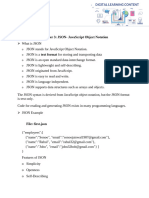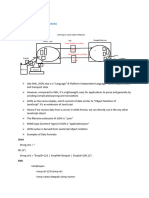"John" "Doe" "Anna" "Smith" "Peter" "Jones"
Uploaded by
Rishi Prakash"John" "Doe" "Anna" "Smith" "Peter" "Jones"
Uploaded by
Rishi Prakash#JSON: JavaScript Object Notation.
#JSON is a syntax for storing and exchanging data.
#JSON is an easier-to-use alternative to XML.
#JSON is language independent
JSON Structure :
{"employees":[
{"firstName":"John", "lastName":"Doe"},
{"firstName":"Anna", "lastName":"Smith"},
{"firstName":"Peter", "lastName":"Jones"}
]}
Corresponding XML:
<employees>
<employee>
<firstName>John</firstName> <lastName>Doe</lastName>
</employee>
<employee>
<firstName>Anna</firstName> <lastName>Smith</lastName>
</employee>
<employee>
<firstName>Peter</firstName> <lastName>Jones</lastName>
</employee>
</employees>
#The JSON format is syntactically identical to the code for creating JavaScript objects.
#Why JSON is faster than XML
For AJAX applications, JSON is faster and easier than XML:
Using XML
Fetch an XML document
Use the XML DOM to loop through the document
Extract values and store in variables
Using JSON
Fetch a JSON string
JSON.Parse the JSON string
#What is the Syntax of JSON
JSON syntax is derived from JavaScript object notation syntax:
Data is in name/value pairs
Data is separated by commas
Curly braces hold objects
Square brackets hold arrays
#JSON in JavaScript
var employees = [
{"firstName":"John", "lastName":"Doe"},
{"firstName":"Anna", "lastName":"Smith"},
{"firstName":"Peter","lastName": "Jones"}
];
employees[0].firstName + " " + employees[0].lastName;
From JSON Valid String to JSON object. JSON.parse
On Java we have org.json.JSONObject uses .put(name,value),JSONArray uses
.add(JSONObject);
#ArrayList/Arrays of Infos have similar structure as that Of JSON
AngularJS MVC Framework
SPA
2WayBinding using ng-model
Scope, rootScope,Scope,ng-app,ng-view,expressions
Controllers
Services
Filters
Module
Directives
rootProviders
You might also like
- Converting a JSON Text to a JavaScript ObjectNo ratings yetConverting a JSON Text to a JavaScript Object4 pages
- 1.3 Study Material For Section-I-Part-I - JSONNo ratings yet1.3 Study Material For Section-I-Part-I - JSON15 pages
- E-Note_4702_Content_Document_20241011091907PMNo ratings yetE-Note_4702_Content_Document_20241011091907PM4 pages
- Javascript Object Notation (Json) : Adnan SohailNo ratings yetJavascript Object Notation (Json) : Adnan Sohail13 pages
- FALLSEM2020-21 CSE3002 ETH VL2020210106410 Reference Material I 26-Sep-2020 6.5 JSONNo ratings yetFALLSEM2020-21 CSE3002 ETH VL2020210106410 Reference Material I 26-Sep-2020 6.5 JSON20 pages
- Json - Introduction: Javascript Object Notation, Commonly Known AsNo ratings yetJson - Introduction: Javascript Object Notation, Commonly Known As16 pages
- JSON and JavaScript_ Comprehensive GuideNo ratings yetJSON and JavaScript_ Comprehensive Guide7 pages
- Understanding JSON: The 3 Minute Lesson: What Does It Stand For?No ratings yetUnderstanding JSON: The 3 Minute Lesson: What Does It Stand For?4 pages
- Introduction To Json (Javascript Object Notation)No ratings yetIntroduction To Json (Javascript Object Notation)21 pages
- Json Interview Questions and Answer Are Below: What Is The Json (Javascript Object Notation) ?No ratings yetJson Interview Questions and Answer Are Below: What Is The Json (Javascript Object Notation) ?4 pages



























































